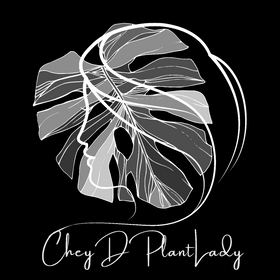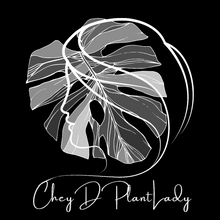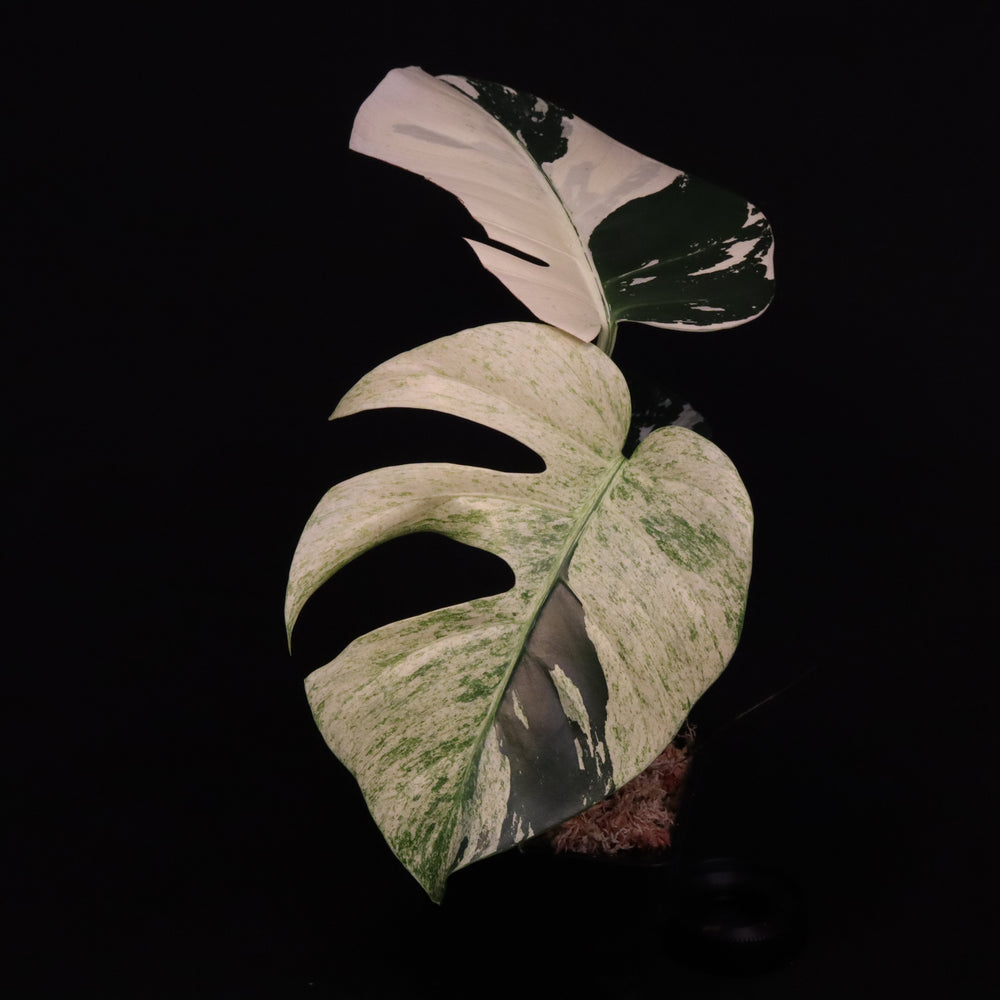A Guide to Variegation
Sometimes it’s hard to believe that variegated plants were once thrown away, being disregarded as sick and undesirable by many. In the last five years, interest in variegated plants have skyrocketed, in part due to the global pandemic and the growth of social media platforms. These trends continue upward, and sometimes it seems there’s a new variegate of an Aroid hitting the market every week. While many plant enthusiasts of all kinds have an understanding that variegation is caused by a genetic mutation, it is not often clear on the ‘how’ or ‘why.’
What is variegation?
The word ‘variegate’ means ‘to vary or diversify with different colors.” Variegated plants most commonly display two colors, but more are possible. Currently there are several known forms of genetic variegation; Gene-pattern, Chimeric, Blister (or Reflective), and Transposons. Variegation is a mutation of the apical meristem, or growth point, and it is the location of the mutation in the growth point that determines how variegation presents.

To help make a bit of sense of this, an explanation of an apical meristem is needed. Scientists have explored what is known as Tunica-Corpus theory, which describes three main cell layers of an apical meristem.
LI, is the outermost layer of the meristem which gives rise to the leaf surface, or epidermis tissue. LII is the ‘middle’ layer of the meristem, which gives rise to majority of the leaf margin and some surface area of the foliage. These two layers make up the Tunica portion of the meristem and are neatly organized in a singular row. The cells in these areas undergo anticlinal (side by side) division.
The third layer, LIII, is known as the corpus, which can undergo both anticlinal and periclinal (vertical) cell division, with this layer becoming the vascular system of the plant.
Gene-pattern variegation is a term used when a plant’s ordinary genetic makeup includes the presence of two or more colors on the foliage. You often see examples of this in plants such as Caladium, Dieffenbachia, and Aglaonema.
Blister Variegation


 Blister variegation, sometimes referred to as reflective variegation, occurs when a thin air pocket is present between the epidermis (outermost layer, or ‘skin’) and the dermis (an inner layer) layers of leaf tissue forms due to being detached from one another. The air pocket then allows light to reflect within the two layers of tissue leading to broad silvery patches on the leaf surface and can, on occasion, cause leaf shape distortion. Many plants with silver foliage or venation can be attributed to this form of variegation, however it is not necessarily always a mutation.
Blister variegation, sometimes referred to as reflective variegation, occurs when a thin air pocket is present between the epidermis (outermost layer, or ‘skin’) and the dermis (an inner layer) layers of leaf tissue forms due to being detached from one another. The air pocket then allows light to reflect within the two layers of tissue leading to broad silvery patches on the leaf surface and can, on occasion, cause leaf shape distortion. Many plants with silver foliage or venation can be attributed to this form of variegation, however it is not necessarily always a mutation. "Jumping Genes"

Aroids displaying speckled or ‘splattered’ patterning on the leaves are often the cause of transposon genes, nicknamed ‘jumping genes.’ The phenomenon was discovered by geneticist Barbara McClintock while working with varieties of ornamental corn, and it often presents several colors and shades throughout the leaf or flower of a plant effected with these types of genetics. Transposons can change position within a genome, via a ‘cut and paste’ method, and can ‘mute’ genes as growth continues. Plants with transposon variegation can be differentiated from chimeras, due to the genetics being inherited by seed.
Chimeric Variegation

Chimeric variegation is responsible for many of the popular variegated Aroids we see offered on the consumer market. Within chimera variegated plants, there are two or more distinct sets of DNA within a single plant; one genetic sequence is able to produce chlorophyll, while the other is not. It can be difficult to differentiate the chimera variegates, and currently there are three recognized forms of chimeric variegation: Mericlinal, Periclinal, and Sectoral.

 Periclinal variegation occurs when an entire single layer of meristem tissue is affected by the mutation. These chimeras are generally one of the most stable, as the mutation often carries through propagation to the next generation, depending on which portion of the meristem carries the mutation. An example of periclinal mutation would include the entirety of LII of the meristem tissue containing the mutation, which would present with a variegated leaf edge or margin, such as Philodendron micans ‘Halo.’ In plants such as Monstera deliciosa ‘White Lava,’ or Epipremnum aureum ‘Mutant Manjula,’ the LIII portion of the meristem is affected by the mutation, resulting in majority of the vascular system of the plant growing pure white.
Periclinal variegation occurs when an entire single layer of meristem tissue is affected by the mutation. These chimeras are generally one of the most stable, as the mutation often carries through propagation to the next generation, depending on which portion of the meristem carries the mutation. An example of periclinal mutation would include the entirety of LII of the meristem tissue containing the mutation, which would present with a variegated leaf edge or margin, such as Philodendron micans ‘Halo.’ In plants such as Monstera deliciosa ‘White Lava,’ or Epipremnum aureum ‘Mutant Manjula,’ the LIII portion of the meristem is affected by the mutation, resulting in majority of the vascular system of the plant growing pure white.
 Mericlinal variegation on the other hand, is known to be an unstable chimera. Like periclinal variegates, a single layer of meristem tissue is affected by the mutation. The key difference, however, is that a mericlinal mutation is only found in a portion of a single effected layer. This kind of mutation is responsible for small, singular patches of variegation on the foliage, and is often a transitional phase of a mutated plant, where the plant will either be able to stabilize the mutation or lose it entirely. I like to think of these little patches of variegation as a genetic ‘hiccup’ of sorts, as I’ve observed this can occur when the plant has undergone a new stressor.
Mericlinal variegation on the other hand, is known to be an unstable chimera. Like periclinal variegates, a single layer of meristem tissue is affected by the mutation. The key difference, however, is that a mericlinal mutation is only found in a portion of a single effected layer. This kind of mutation is responsible for small, singular patches of variegation on the foliage, and is often a transitional phase of a mutated plant, where the plant will either be able to stabilize the mutation or lose it entirely. I like to think of these little patches of variegation as a genetic ‘hiccup’ of sorts, as I’ve observed this can occur when the plant has undergone a new stressor.



Sectoral variegated plants are known to be relatively unstable, however the genetics can be carried on by selective propagation and encouraging balanced amounts of variegated and ordinary leaf tissue. The mutation occurs through entire sections of all three layers of the meristem tissue, resulting in bold sections of entirely, or predominantly variegated leaf tissue. Sectoral variegates are now becoming easily accessible to collectors after taking the plant collector world by storm and seeing a sharp rise in popularity at the onset of the global pandemic.
This article was was written and published by Cheyan DuVal in Volume 46, No. 3. August 2024 newsletter of The International Aroid Society. All images, and text are copyright protected, and explicit permission is required for use or publication.


